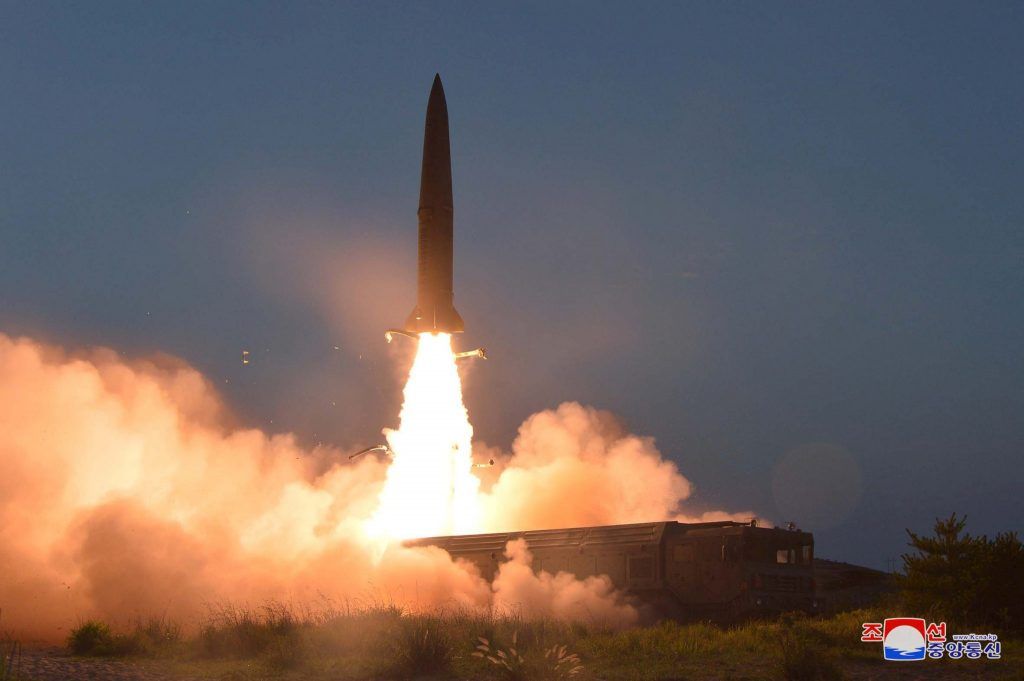Why Rocket Man is going ballistic with short-range missiles
By Duyeon Kim | August 8, 2019
 A recent North Korean missile launch. Photo: KCNA
A recent North Korean missile launch. Photo: KCNA
North Korea is on an arms-testing binge. It began to fire short-range ballistic missiles in May, flaunted what apparently is a ballistic missile-carrying submarine on July 23, fired two more rounds of what appeared to be similar short-range missiles on July 25, another two rounds on July 31, another two on August 2, and yet another two on August 5. Even though US President Donald Trump and North Korean leader Kim Jong Un agreed to hold them soon after their impromptu meeting at the inter-Korean border in late June, negotiations on North Korea’s nuclear program have yet to convene. It now seems that any working-level talks between Washington and Pyongyang on the North’s nuclear program will be pushed back until some uncertain point after US-South Korean military drills end in a couple of weeks, marking mid-September as the earliest that bilateral negotiations could start, if conditions are right under Pyongyang’s terms.
But why is Pyongyang conducting such frequent fireworks now? North Korea typically has several objectives for every official action and statement on security matters, and so this is not a single-answer question.
One reason for these launches: Trump has given Pyongyang a pass on short-range ballistic missile tests, most recently repeating his mantra of “I have no problem, we’ll see what happens but short-range [missiles] are very standard.” So the regime is freely testing them to strengthen its military capabilities, the main objective of the July 31 tests, based on the North’s reporting of the tests through its Workers Party newspaper, the Rodong Sinmun, which is aimed at domestic audiences.
Perhaps Trump is picking his battles, hoping to give yet-to-be-held negotiations a chance to begin and blossom. But his virtual blessing for short-range ballistic missile tests is telling his allies, South Korea and Japan, and American soldiers and expatriates that they are dispensable. This message reinforces existing security concerns in South Korea and Japan that Washington may not defend its Asian allies at critical moments, especially if US territory becomes vulnerable to a North Korean nuclear attack. And as Melissa Hanham and I explained extensively in the Bulletin in May, the Iskander-type missile being tested could carry a nuclear or conventional warhead and is, in and of itself, genuinely dangerous for South Korea, Japan, and American troops and civilians in both countries.
The Trump administration certainly need not overreact to tests of short-range missiles, but a proportionate response would not necessarily kill diplomacy. The United Kingdom, France, and Germany were right to at least convene a closed-door UN Security Council meeting on August 1 and issue a joint statement urging Pyongyang “to take concrete steps towards complete, verifiable and irreversible denuclearization” and calling on the Security Council for “unity in upholding its resolutions” that back a range of sanctions aimed at drying up funding for Pyongyang’s nuclear and missile programs.
A second reason for the recent missile tests: Pyongyang has been trying to cancel or further shrink US-South Korean combined military exercises for months. The North had been protesting these drills and criticized Seoul after its July 25 tests (through its state media, KCNA, which is aimed at international audiences) for receiving American F-35A stealth fighters and for essentially betraying its nationalistic roots by being “imperialist” America’s puppet (a common metaphor used by Pyongyang). The North’s Foreign Ministry released a statement on August 6 criticizing Washington and Seoul for failing to take its demands about ending military exercises seriously and threatening to reconsider future dialogue. The latest tests and statement also send a reassuring message to North Koreans that Pyongyang will not be pushed around by Washington.
Actually, the United States scrapped large-scale defensive exercises with South Korea and replaced them with much smaller drills after the June 2018 Singapore summit. This month’s exercises (beginning with initial staff training sessions in the run up to official drills this weekend) are merely command post affairs, using computer simulations to deal with contingency scenarios and to test Seoul’s basic operational capabilities for a future, conditions-based transfer of wartime operational control (OPCON) from Washington to Seoul. If Pyongyang decides to eventually walk away from diplomacy, it may well cite a hostile environment on the Korean Peninsula caused by American military assets and drills—all while Pyongyang has continued its ballistic missile tests and not altered or canceled its winter or summer military exercises.
A third reason for the missile tests involves negotiating strategy. It appears that Pyongyang is aiming to walk into future talks with Washington in a position of strength. After all, Kim Jong Un declared before his Supreme People’s Assembly in April—one month after the no-deal Hanoi summit with Trump—that his country will continue to strengthen its military capabilities. Testing short-range ballistic missiles as opposed to those of longer range is Pyongyang’s way of avoiding directly provoking Trump and averting blame should diplomacy collapse, while at the same time engaging in gray zone provocations that strengthen its arsenal and threaten its neighbors.
Testing short-range ballistic missiles, however, is still a violation of UN Security Council resolutions that ban North Korea from any ballistic missile activity and development of related technology. The recent tests also violate the September 2018 inter-Korean military pact, which calls on the North and South to “completely cease all hostile acts against each other in every domain, including land, air and sea that are the source of military tension and conflict.” The North’s Foreign Ministry criticized the UN Security Council for convening a closed-door meeting on August 1, saying the North “has never recognized UNSC ‘resolutions’ against it and will not recognize them in the future too as they were illegally fabricated by the UN to its taste.” By disregarding their recent military pact, North Korea also has reaffirmed that it regards Seoul as subordinate, and its real interest involves dealing directly with the United States.
Perhaps an unintended yet effective result of these tests is the further degradation of South Korea-Japan cooperation. Seoul and Tokyo are engaged in a fierce trade spat that has paralyzed diplomacy on other issues. In the past, North Korean military provocations have forced South Korea and Japan to compartmentalize their various disputes and cooperate on the North Korea problem. On July 4, however, Tokyo tightened export controls on three high-tech materials that are vital to South Korea’s semiconductor and display manufacturers. Its subsequent removal of South Korea from a “whitelist” of trusted trade partners has led Seoul to warn that it could reexamine security cooperation frameworks in place with Tokyo, particularly a 2016 military-intelligence sharing agreement on North Korean nuclear and missile developments that is set to expire in November. The pact stipulates that either party needs to notify its intent to withdraw by August 24.
North Korea’s four rounds of ballistic missile tests in under two weeks have gradually increased concerns in South Korea about its security. These concerns have coincided with Washington’s withdrawal last Friday from the 1987 Intermediate-range Nuclear Forces (INF) Treaty with Moscow. The end of the INF was accompanied by US Defense Secretary Mark Esper’s suggestion that Washington is considering deploying intermediate-range missiles in Asia. Those events have renewed debate in Seoul over the reliability of the US nuclear umbrella.
Esper’s remarks are welcome news for some conservative politicians and defense analysts in South Korea (and in some circles in Japan) who have been calling for either the reintroduction of US tactical nuclear weapons or a NATO-style nuclear sharing arrangement between Washington and Seoul. These voices are still on the fringe of general public sentiment, but will likely continue to grow if South Koreans perceive Washington and Beijing as ambivalent about solving the North Korean nuclear problem while Pyongyang’s nuclear weapons capabilities advance. Although a unified agreement does not exist across the various ministries in the South Korean government and among defense specialists on what a nuclear planning mechanism might look like, the term “nuclear sharing” is increasingly used in South Korean public discourse today.
At the same time, Esper’s comments have sparked concerns across party lines and in wider circles of the South Korean policy community that deploying intermediate-range missiles in Asia will ignite an arms race with China and Russia, and stationing such weapons in South Korea would invite Chinese economic retribution and Russian muscle-flexing. Seoul learned retribution politics the hard way in 2016, when the deployment of the US Terminal High-Altitude Area Defense (THAAD) missile defense system led China, its largest trading partner, to boycott South Korean goods and tourism. In late July, Seoul fired hundreds of warning shots and Tokyo strongly protested a joint Russian-Chinese air patrol that led to the violation of South Korean and Japanese air spaces.
As tensions continue to rise across Northeast Asia and China, Russia, and North Korea take advantage of shaky US alliance relations, the negotiating clock is ticking. Pyongyang’s end-of-year deadline for Trump to pitch an acceptable proposal is fast approaching, with the president soon to enter an election year. Although Kim has been pressured domestically to deliver on pledges to improve his country’s economy, he has a secure lifeline of Chinese economic and political support and will be a winner, even in the absence of a real nuclear agreement with Trump. In that case, Kim will retain his international standing and, most important, his nuclear weapons, including those that may fit a class of newly tested, short-range, and extremely lethal missiles. And if Washington, Seoul, and Tokyo fail to regroup soon, then Beijing, Moscow, and Pyongyang will be the winners in the region.
Together, we make the world safer.
The Bulletin elevates expert voices above the noise. But as an independent nonprofit organization, our operations depend on the support of readers like you. Help us continue to deliver quality journalism that holds leaders accountable. Your support of our work at any level is important. In return, we promise our coverage will be understandable, influential, vigilant, solution-oriented, and fair-minded. Together we can make a difference.
Topics: Columnists, Nuclear Weapons















President Trump is mystifying on his reaction to the missile tests. To me, his talk about the letters and his “friendship” with the North Korean leader sounds insane. On the other hand, he breaks the agreement with Iran, which seems like almost the opposite extreme. Seems like testing the intermediate range missiles is the same thing, can’t the technology be similar to ballistic missiles. But President Trump seem unfazed by the tests and seems to take NK side on the military training stuff. What kind of odd delusion does Trump have?
It could just be that Trump’s efforts have been a total failure and he can do nothing about these tests at this point. Now his only option is to try to save face by brushing the tests off.
Republican position has long been that US has the right to develop ANY missiles, since G.W. Bush tore up the Ballistic missile treaty. They also don’t really care what missiles anyone else has as long as they aren’t capable of hitting them, which is why they quit the Iran deal and started maximum pressure campaigns on them and North Korea. They don’t care if Kim can mount a thermonuke on a shorter range missile as long as it isn’t aimed at them.